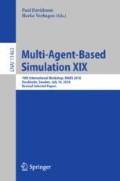Abstract
Herd behavior is a cognitive bias in humans which is one of the causes of inappropriate or irrational behavior during evacuations. Although previous work in evacuation simulations have incorporated cognitive biases for realistic results, most of this work has focused on predefined rules or roles to implement these biases, leaving them unable to investigate the cause of herd behaviors. In this paper, an evacuation decision model based on the biological response threshold model is presented to reproduce human herd behaviors in evacuations. Since this model is independent of any predefined rules, it can be used for in-depth analysis of herding. Evacuation simulations using this model reveals that the uneven spatial distribution of evacuees causes an increase in the number of evacuees per unit time. It also shows that as the population density of the room increases, the number of evacuees per unit time increases rapidly.
Access this chapter
Tax calculation will be finalised at checkout
Purchases are for personal use only
Notes
- 1.
The evacuation times were unchanged regardless of the number of agents in the case of random start.
- 2.
The factors associated with the social force model are not purely physical. Psychological tendencies of two pedistrians to stay away from each other are incorporated. However, the original causes of such factors are the physical existence of walls or others, thus we call them physical factors.
References
Bonabeau, E., Theraulaz, G., Deneubourg, J.L.: Quantitative study of the fixed threshold model for the regulation of division of labour in insect societies. Proc. R. Soc. B 263(1376), 1565–1569 (1996)
Bratman, M.: Intention, Plans, and Practical Reason. Harvard University Press, Cambridge (1987)
Bulumulla, C., Padgham, L., Singh, D., Chan, J.: The importance of modeling realistic human behaviour when planning evacuation schedules. In: Proceedings of the 16th International Conference on Autonomous Agents and Multiagent Systems, AAMAS 2017, pp. 446–454 (2017)
Cutter, S., Barnes, K.: Evacuation behavior and Three Mile Island. Disasters 6(2), 116–124 (1982)
Dyer, J.R.G., et al.: Consensus decision making in human crowds. Anim. Behav. 75, 461–470 (2008)
Elliott, D., Smith, D.: Football stadia disasters in the United Kingdom: learning from tragedy? Ind. Environ. Crisis Q. 7(3), 205–229 (1993)
Faroqi, H., Mesgari, M.S.: Agent-based crowd simulation considering emotion contagion for emergency evacuation problem. In: International Conference on Sensors and Models in Remote Sensing and Photogrammetry, pp. 193–196 (2015)
Festinger, L.: A theory of social comparison processes. Hum. Relat. 7(2), 117–140 (1954)
Helbing, D., Farkas, I., Vicsek, T.: Simulating dynamical features of escape panic. Nature 407(28), 487–490 (2000). http://angel.elte.hu/panic/
Helbing, D., Farkas, I.J., Molnar, P., Vicsek, T.: Simulation of pedestrian crowds in normal and evacuation situations. Pedestr. Evacuation Dyn. 21(2), 21–58 (2002)
Henrich, J., Boyd, R.: The evolution of conformist transmission and the emergence of between-group differences. Evol. Hum. Behav. 19, 215–241 (1998)
Iwanaga, S., Matsuura, Y.: Considering psychological conditions in a Tsunami evacuation simulation. Commun. Comput. Inf. Sci. 442, 437–446 (2014)
Marlair, G., Le Coze, J.C., Woon-Hyung, K., Galea, E.R.: Human behavior as a key factor in tunnel fire safety issues. In: Asia-Oceania Symposium on Fire Science & Technology, pp. 658–668 (2004)
Mawson, A.R.: Understanding mass panic and other collective responses to threat and disaster. Psychiatry 68(2), 95–113 (2005)
Okaya, M., Niwa, T., Takahashi, T.: TENDENKO: agent-based evacuation drill and emergency planning system. In: Proceedings of the 13th International Conference on Autonomous Agents and Multiagent Systems, AAMAS 2014, pp. 1669–1670 (2014)
Okaya, M., Southern, M., Takahashi, T.: Dynamic information transfer and sharing model in agent based evacuation simulations. In: Proceedings of 12th International Conference on Autonomous Agents and Multiagent Systems, AAMAS 2013, pp. 1295–1296 (2013)
Raafat, R.M., Chater, N., Frith, C.: Herding in humans. Trends Cogn. Sci. 13(10), 420–428 (2009)
Sivers, D.: How to start a movement. In: TED 2010 (2010). https://www.ted.com/talks/derek_sivers_how_to_start_a_movement
Tsai, J., et al.: ESCAPES - evacuation simulation with children, authorities, parents, emotions, and social comparison. In: Proceedings of 10th International Conference on Autonomous Agents and Multiagent Systems, AAMAS 2011, pp. 457–464 (2011)
Wilensky, U.: NetLogo (1999). http://ccl.northwestern.edu/netlogo/. Center for Connected Learning and Computer-Based Modeling, Northwestern University, Evanston, IL
Acknowledgements
The author is grateful to Yoshikazu Shinoda and Kei Marukawa for their helpful comments and suggestions.
Author information
Authors and Affiliations
Corresponding author
Editor information
Editors and Affiliations
Rights and permissions
Copyright information
© 2019 Springer Nature Switzerland AG
About this paper
Cite this paper
Tsurushima, A. (2019). Modeling Herd Behavior Caused by Evacuation Decision Making Using Response Threshold. In: Davidsson, P., Verhagen, H. (eds) Multi-Agent-Based Simulation XIX. MABS 2018. Lecture Notes in Computer Science(), vol 11463. Springer, Cham. https://doi.org/10.1007/978-3-030-22270-3_11
Download citation
DOI: https://doi.org/10.1007/978-3-030-22270-3_11
Published:
Publisher Name: Springer, Cham
Print ISBN: 978-3-030-22269-7
Online ISBN: 978-3-030-22270-3
eBook Packages: Computer ScienceComputer Science (R0)

